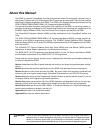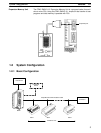
1-1SectionSRM1 Features and Functions
2
1-1 SRM1 Features and Functions
1-1-1 Features
The SRM1 is a special CompoBus/S controller that provides remote I/O with
greatly reduced wiring. The SRM1 has no built-in I/O terminals, but it can provide
the same I/O control as earlier PCs through the Slaves (Slave Terminals) that
are used for I/O.
A decentralized I/O system with up to 32 Slaves can be constructed. The system
can have up to 256 I/O points and these I/O points are controlled with the Com-
poBus/S System’s high-speed response time of 1 ms max.
A very reliable and efficiently wired system can be constructed from special
CompoBus/S components such as Analog Terminals (SRM1-C0j-V2 only),
Remote Terminals, Sensor Terminals, Communications Cables, Connectors,
and Terminators.
In SRM1-C0j-V2, the CompoBus/S system can be set to operate in long-dis-
tance communications mode in addition to the previous high-speed commu-
nications mode. This allows a main line length of up to 500 m so that I/O devices
can be controlled from some distance away. The SRM1-C0j-V2 can also pro-
cess analog data as well as digital I/O.
The SRM1’s compact design allows for a smaller and thinner control panel.
The SRM1 is equipped with a program capacity of 4K words and a DM capacity
of 2K words.
There are two SRM1(-V2) models available: the SRM1-C02-V2, which is
equipped with an RS-232C port and communications functions, and the very
cost-effective SRM1-C01-V2, which is not equipped with an RS-232C port.
1-1-2 Functions
The SRM1 is equipped with an interval timer which can be set from 0.5 ms to
319,968 ms in units of 0.1 ms. The timer can be set to trigger a single interrupt
(one-shot mode) or repeat scheduled interrupts (scheduled interrupt mode).
(The interrupts pause execution of the main program while an interrupt program
is executed.)
Low-maintenance Design Memory can be backed up without a battery by using flash memory.
Communications The SRM1 can communicate with PCs or other devices via Host Link, 1:1 NT
Link, 1:N NT Link, 1:1 PC Link, or RS-232C communications.
Port Applicable communications functions
Peripheral Port Peripheral device connections, Host Link, and RS-232C
communications
RS-232C Port Host Link, 1:1 NT Link, 1:N NT Link, 1:1 PC Link, and no-protocol
(RS-232C) communications
Programming is possible through the PT (Programmable Terminal) screen us-
ing an OMRON PT that contains Programming Console functions. (This applies
only to the SRM1-C02-V1 and SRM1-C02-V2.)
Standard Peripheral Devices The SRM1 uses the same Programming Consoles, CX-Programmer, SYSMAC-
CPT, and SYSMAC Support Software (SSS) as the Mini H-type, CQM1,
CPM1/CPM1A, and CPM2A/CPM2C PCs.
Interval Timer Function
Programming Using the
PT


















